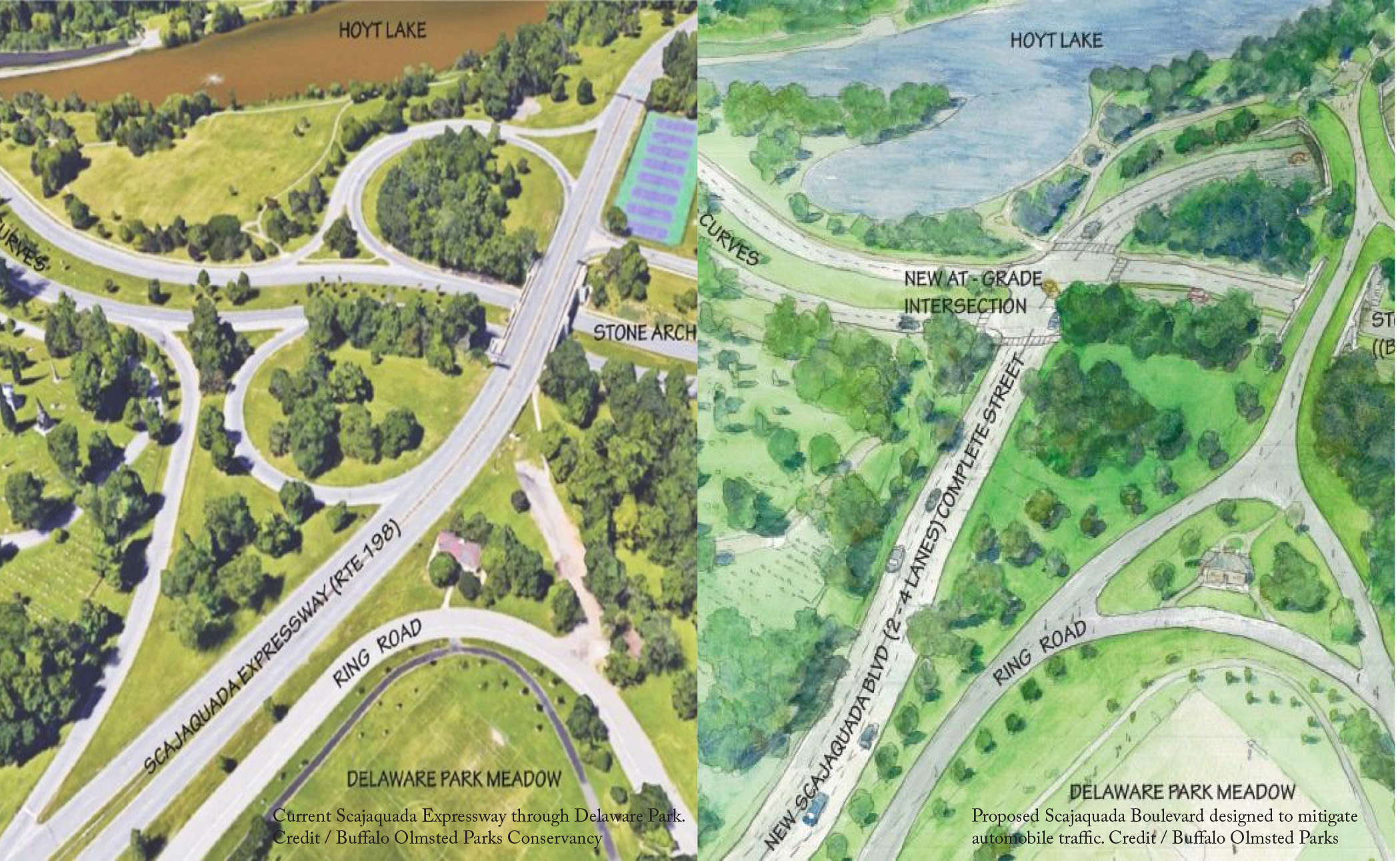- Who We Are
- What We Do
- Our Issues
- Our Projects
- Sprawl Retrofit
- Highways to Boulevards
- CNU/ITE Manual
- Health Districts
- The Project for Code Reform
- Lean Urbanism
- LEED for Neighborhood Development
- Missing Middle Housing
- Small-Scale Developers & Builders
- Emergency Response
- HUD HOPE VI
- Rainwater in Context
- Street Networks
- HUD Finance Reform
- Affordable Neighborhoods
- Autonomous Vehicles
- Legacy Projects
- Build Great Places
- Education & Trainings
- Charter Awards
- Annual Congress
- Athena Medals
- Resources
- Get Involved
- Donate
- Membership
- Public Square
History and Context
When the Scajaquada Expressway was built along New York State Route 198 in Buffalo, it bisected and severed Delaware Park—a masterpiece designed by the celebrated urbanist Frederick Law Olmsted. Constructed in the early 1960s, the 3.6-mile four-lane highway carries between 37,600 and 65,000 vehicles per day between Interstate 190 and State Route 33, another expressway. In addition to cutting through Delaware Park, the Scajaquada runs alongside the 10,000-student campus of Buffalo State, approximately two miles north of downtown.
Proposal
For decades, community members have demanded that the expressway be redesigned as a parkway to cut noise, pollution, and dangerous high-speed traffic—and to reconnect Delaware Park to adjacent neighborhoods. Now, the project has support of Governor Andrew Cuomo, the New York State Department of Transportation (NYSDOT), and local Buffalo stakeholders.
In 2005, the City of Buffalo and NYSDOT conducted a study known as the Expanded Project Proposal (EPP) to explore ways to redesign the Scajaquada and alleviate negative impacts on the community. With significant public input, the EPP established a preferred design that reduced vehicular speed to 30 miles per hour, improved the aesthetic of the thoroughfare, and incorporated pedestrian crossings and bicycle lanes.
In the summer of 2015, following a tragic crash, when a sedan traveling on the expressway jumped a barrier, veered into Delaware Park, killed a three-year-old boy, and severely injured his five-year-old sister, NYSDOT made swift short-term improvements, decreasing posted speeds from 50 to 30 mph, and reducing all 12-foot lanes to 11 feet. Later, the DOT installed raised-table pedestrian crosswalks, new, sturdier guard railings, and additional safety improvements.
In April of 2016, Cuomo dedicated $30 million in state funding for the conversion of Scajaquada Expressway into a low-speed urban boulevard. At the time, Cuomo told the Buffalo News: “In the mid-’50s, we had a better idea and it turned out not to be a better idea, which was to move vehicles in and out of Buffalo faster by building a highway. This was not just in Buffalo; this was all over the United States. Most places have reversed their mistakes, and that’s what we are going to be doing here.”

Community members advocate for a transformation of the Scajaquada Expressway into a tree-lined boulevard/parkway to reduce noise and pollution, increase safety, and reconnect adjacent neighborhoods’ access to the park. The vision pays homage to Olmsted’s original plan and would consolidate the cultural assets, now separated by the highway, that border the park. These assets include the Albright-Knox Art Gallery and the Buffalo History Museum, which would be within walking distance of each other—if not for the four-lane barrier.
Thanks to the combined efforts of Buffalo’s community organizations, NYSDOT withdrew their January 2018 proposal to rebuild the Scajaquada corridor using highway-like design with limited traffic calming measures. Instead, it will reconsider community-based designs. Stephanie Crockatt, Executive Director of the Buffalo Olmsted Parks Conservancy, hailed the decision as a benefit to Buffalonians now and in the future: “Today we can say clearly that the community has been heard. Thanks to the effort of so many concerned citizens who worked so hard over these past several months, we now have an opportunity to restore the jewel of Olmsted’s system.”


















